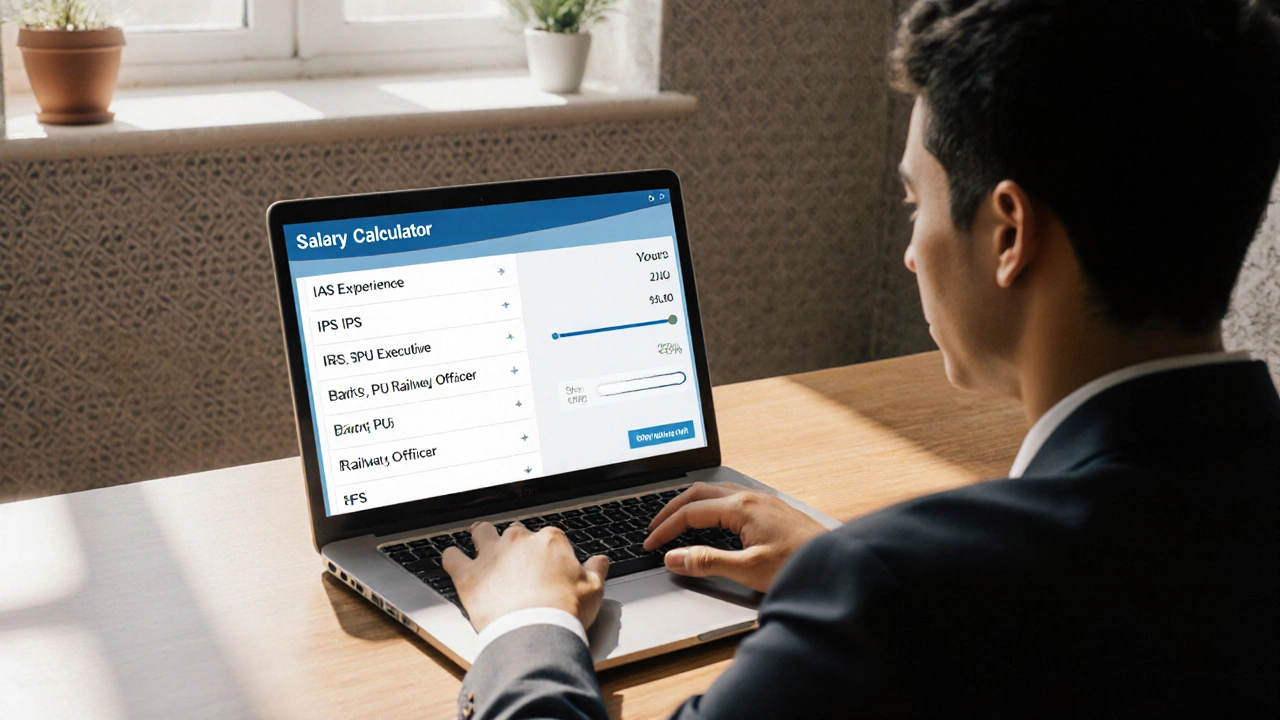Government Job Salary Calculator
Estimated Monthly Earnings
Basic Pay: ₹1,40,000
Dearness Allowance (DA): ₹42,000
House Rent Allowance (HRA): ₹33,600
Total Gross Pay: ₹2,15,600
Additional Allowances: Transport, Medical, Travel
Annual Earnings: ₹25,87,200
Key Benefits
- Job Security
- Medical Facilities
- Pension After 20 Years
- Leave Encashment
Top Government Jobs in India (2025)
| Job | Starting Basic Pay | Allowances |
|---|---|---|
| IAS | ₹1,40,000 | DA, HRA (24%), Transport, Medical |
| IPS | ₹1,40,000 | DA, HRA (24%), Travel, Crime Scene |
| IRS | ₹1,40,000 | DA, HRA (24%), Transport, Medical |
| Bank PO | ₹74,000 | DA, HRA (12-24%), Travel, Medical |
| PSU Executive | ₹85,000 | DA, HRA (15-24%), Performance Bonus |
| Railway Officer | ₹69,000 | DA, HRA (12-24%), Free Tickets, Housing |
| IFS | ₹1,40,000 | DA, HRA (24%), Foreign Posting |
When you start hunting for a stable career that also puts a good chunk of money in your bank, the first question is usually: government job salary matters more than anything else. The reality is that not all government posts are created equal-some offer a starting package that rivals top private‑sector offers, while others pay modestly but compensate with job security and perks. Below is a quick snapshot of the highest‑earning government roles, how their pay structures work, and what you need to clear to land one.
- IAS, IPS, IFS, IRS - six‑figure basic pay plus extensive allowances.
- Bank PO - attractive starting salary with regular increments.
- PSU executive - competitive fixed pay and performance bonuses.
- Railway Officer - strong base plus housing and travel benefits.
- Defence officer - high initial pay plus pension and field allowances.
Understanding Government Salary Structure
Before comparing numbers, it helps to know what makes up a typical government paycheck. Most posts follow the government job salary framework that includes a basic pay, dearness allowance (DA), house rent allowance (HRA), and various special allowances depending on the posting. The basic pay is fixed in the Pay Commission’s salary matrix, while DA is linked to inflation, and HRA varies by city (typically 8‑24% of basic). Beyond that, many services grant travel, medical, and education allowances that can push the gross earnings well beyond the basic figure.
Highest‑Paying Government Jobs (2025 Figures)
Here’s a rundown of the most lucrative posts as of the latest 7th Pay Commission update. Figures are rounded to the nearest thousand for readability.
| Job | Starting Basic (₹/month) | Key Allowances | Promotion Timeline | Typical Eligibility |
|---|---|---|---|---|
| Indian Administrative Service (IAS) All‑India Service overseeing district administration | ₹1,40,000 | DA, HRA (24%), transport, medical | 2-3 years to Junior/Selection Grade | UPSC Civil Services - 21‑30 yrs |
| Indian Police Service (IPS) Senior police leadership | ₹1,40,000 | DA, HRA (24%), travel, crime‑scene allowance | 3‑4 years to Superintendent | UPSC Civil Services - 21‑30 yrs |
| Indian Revenue Service (IRS) Tax administration and collection | ₹1,40,000 | DA, HRA (24%), transport, medical | 4‑5 years to Senior Tax Officer | UPSC Civil Services - 21‑30 yrs |
| Bank Probationary Officer (Bank PO) Entry‑level officer in public sector banks | ₹74,000 | DA, HRA (12‑24%), travel, medical | 2‑3 years to Assistant Manager | IBPS PO - 21‑30 yrs, graduation |
| PSU Executive Management role in public sector undertakings | ₹85,000 | DA, HRA (15‑24%), performance bonus | 3‑5 years to Manager | GATE / PSU specific exams, graduation |
| Railway Officer (IRSR) Indian Railway Service of Engineers | ₹69,000 | DA, HRA (12‑24%), free rail tickets, housing | 2‑3 years to Senior Engineer | UPSC Engineering Services - 21‑30 yrs |
| Indian Foreign Service (IFS) Diplomatic corps | ₹1,40,000 | DA, HRA (24%), foreign posting allowance | 4‑5 years to Third Secretary | UPSC Civil Services - 21‑30 yrs |
Eligibility & Selection Process - What It Takes
All the high‑paying posts share a common entry gate: the Union Public Service Commission (UPSC) or a specialized recruiting body. For IAS, IPS, IRS, and IFS, you’ll need to clear the three‑stage Civil Services Examination (Pre‑lims, Mains, Interview). Bank PO aspirants sit for the IBPS PO exam, while PSU aspirants usually face GATE scores or specific PSU written tests. The engineering services exam opens doors to Railway Officer roles. In every case, the age limit sits between 21 and 30 years, and a graduation degree is mandatory.
Success rates are low-often under 0.5% for the civil services-so early preparation, consistent mock tests, and a clear understanding of the syllabus are non‑negotiable.

Salary Growth, Perks, and Hidden Benefits
Even if a posting starts at the same basic pay, the real earning power diverges over time. IAS officers, for instance, jump from the Junior Administrative Grade (₹1.4L basic) to the Senior Administrative Grade (₹2.5L basic) within 10‑12 years, plus they receive a housing allowance that can exceed ₹1L per month in metros. PSU executives enjoy performance‑linked bonuses that can add 30‑50% to their gross annually. Bank POs get annual pay hikes (around 7‑9%) and can move to senior management positions where the basic climbs above ₹2L.
Other non‑cash perks matter too: free or subsidized accommodation, government‑run health facilities, pension after 20 years of service, and generous leave policies. Those benefits, when monetized, can easily shave off several lakhs from your personal expenses.
How to Prepare for the Top‑Paying Exams
- Start with the syllabus. For civil services, focus on NCERT basics, current affairs, and optional subjects you enjoy. For Bank PO, prioritize quantitative aptitude, English, and reasoning.
- Build a routine that covers each subject weekly. Consistency beats cramming for these exams.
- Use reputable coaching material or free resources like the Ministry of Education’s open‑education portal for NCERT texts.
- Take full‑length mock tests every fortnight. Analyze mistakes and keep a mistake‑log spreadsheet.
- Stay updated with daily news from reliable newspapers (The Hindu, Indian Express) and monthly current‑affairs magazines.
- Join a study group or online forum where you can discuss tricky questions and share notes.
- Maintain physical and mental health-regular walks, a balanced diet, and short breaks improve retention.
Quick Decision Checklist: Which High‑Paying Govt Job Fits You?
- Do you love administration, policy‑making, and field work? IAS/IPS/IFS are the go‑to choices.
- Is finance and taxation your strength? IRS offers comparable pay with less field travel.
- Prefer a bank environment with clear promotion ladders? Bank PO is ideal.
- Enjoy engineering and large‑scale infrastructure? Railway Officer gives good pay and technical challenges.
- Want corporate‑style work within a public sector? Target PSU executive roles.
Match your interests, educational background, and willingness to invest time in preparation with the above points, and you’ll land the most financially rewarding government post for you.
Common Mistakes to Avoid
- Chasing salary alone and ignoring job nature-burnout hits hard if you dislike the daily duties.
- Skipping the interview stage preparation for civil services; personality assessment scores can make or break the final rank.
- Underestimating the importance of DA and inflation adjustments-real‑term earnings can vary year to year.
- Ignoring state‑level opportunities; many state civil services (e.g., Provincial IAS) provide similar pay with lower competition.

Frequently Asked Questions
Which government job pays the highest salary in India?
The Indian Administrative Service (IAS), along with other All‑India Services like IPS, IRS, and IFS, offers the highest basic pay (around ₹1.4L per month) plus a wide range of allowances, making them the top earners in the public sector.
How does an IAS salary compare with a private‑sector IT manager?
A mid‑level IT manager may earn ₹20‑30L gross per year, while an IAS officer’s gross (including allowances) can exceed ₹25‑30L after 5‑7 years of service, plus pension benefits that continue after retirement.
Are there hidden costs in government jobs (e.g., transfers, postings)?
Transfers are routine, but the government usually provides housing, travel, and medical allowances that offset relocation expenses. The main “cost” is the personal adjustment to new locations.
What is the fastest route to become a Bank Probationary Officer?
Clear the IBPS PO exam, which consists of three stages: Preliminary, Mains, and Interview. Preparation time averages 9‑12 months for a dedicated candidate.
Do government salaries keep up with inflation?
Yes, the Dearness Allowance (DA) is revised quarterly based on the Consumer Price Index, so the real purchasing power of a government salary is protected against inflation.

